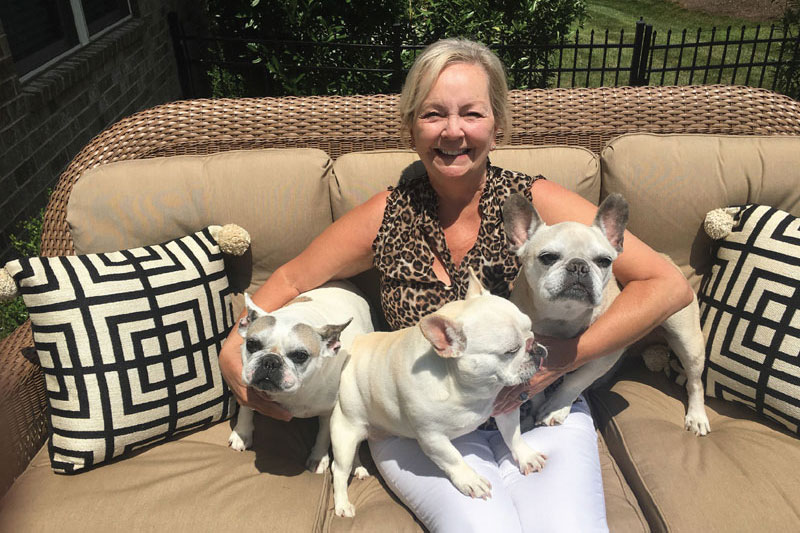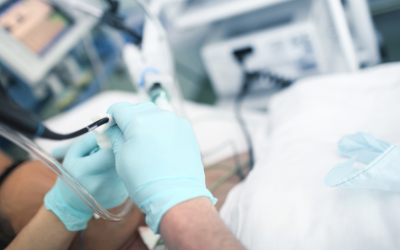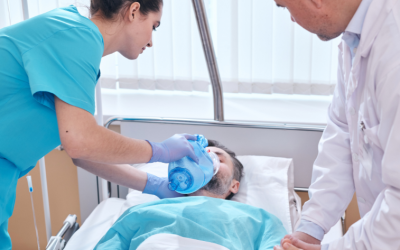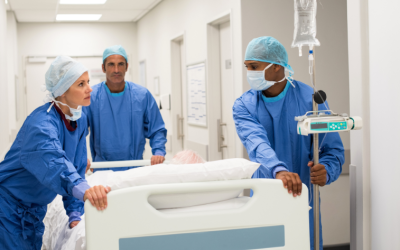“He Saved My Life”

Deborah and her three four-legged friends
Deborah Bunner had no plans for a hip replacement. Believing she suffered from arthritis, she endured significant pain in her hip over the past four years. “It was excruciating. I know now that I was foolish for not going to a specialist sooner.”
Bunner lives in West Knoxville with her husband and three French bulldogs. Last autumn, the retired kindergarten teacher consulted her physician about her persistent hip pain, and she had an MRI. She received a phone call that same afternoon. The MRI had revealed a large mass in her uterus. I would recognize Bunner underwent a hysterectomy, or removal of the uterus and ovaries, in December 2019. The surgery included removal of the tumor and she healed nicely. She thought that perhaps it was the mass in her uterus that had caused her hip pain, and now it would cease. She was wrong.
Divine Intervention
A short three months later, the hip pain had progressed. Bunner walked with two canes because her pain was so debilitating. While she was hanging clothes in her closet, one of the canes slipped and she took a tumble onto the hardwood floor, causing her left hip to fracture on impact. An ambulance brought her to Parkwest Medical Center.
“That is when I met Dr. Hamilton — he was the surgeon on call that day,” remembers Bunner. “He looked at my scans and told me we had an issue.” The fracture revealed a sarcoma tumor in her hip. “Had I not fallen and fractured my hip, we would not have found it.” She recalls, amazed, “The tumor in my hip was not visible in scans before because it was inside, sitting there like an egg.”
D. Hunter Hamilton, MD, is an orthopedic surgeon at Parkwest Medical Center who is fellowship-trained in hip and knee replacement. “When you get mechanical joint pain, or pain with daily activity, it often means you have degenerative changes within the joint, like arthritis,” says Dr. Hamilton. “In this case, it was the tumor, which had spread from the uterus to the inside of the hip and was eroding the bone, making the bone weak and causing pain.”
Bunner says she gets chills thinking back on the divine intervention that occurred that day. “I am just so thankful and blessed.”
Hip Reconstruction
Bunner says she communed with God for the hours leading up to surgery. “I had no fear; I knew everything was going to be fine.”
“On top of that,” she says, “I had this endearing, comforting man as my doctor. He went above and beyond for me. When I told him about my faith, he offered to pray with me. He was confident he would get me back on my treadmill. Now I’m on it every day.”
Dr. Hamilton is accustomed to performing both hip and knee replacements In Bunner’s case, he performed a cemented left hip hemiarthroplasty (“hemi” meaning half and “arthroplasty” meaning joint replacement). Dr. Hamilton removed the part of the tumor he could see and any weakened bone surrounding it. He reconstructed her hip with a cemented partial replacement. He chose a cemented implant over an implant that is “wedged” into place that requires bone to ingrow for stability because the cement will provide implant stability in case she requires future radiation to the hip that could prevent bony ingrowth resulting in a loose stem. He chose a partial hip replacement instead of a total hip replacement in the hope of preventing spread of the tumor to the pelvic side of the hip joint.
He reports, “She had a leiomyosarcoma, a tumor that was identical to the one removed from her uterus. It has spread to her hip.” Dr. Hamilton notes that had the tumor not been removed, there was a risk for soft tissue and muscle tissue cells to metastasize to other places in the body, including spreading to the lungs.
“Beyond Thrilled”
“When Dr. Hamilton informed me there was a cancerous tumor inside my hip, I felt relief. I thought, ‘Thank goodness, now we know what’s wrong!’
“A few hours after surgery, a nurse helped me stand. I was beyond thrilled because the pain was just… gone. That horrible pain I had endured for years had vanished. I was beyond thrilled.”
Following surgery, Bunner’s CT scan and PET scan were clear, indicating no sign of cancer.
“It’s a privilege and it’s gratifying,” says Dr. Hamilton. “As orthopedic surgeons, to restore function, often quite rapidly, we get to see how much life has improved for a patient, and how differently people carry themselves.”
Dr. Hamilton encourages people to not be afraid of surgery because Parkwest has specialists in so many areas. “Overall, I’d say if joint pain is affecting your quality of life and keeping you from being able to do what you enjoy doing, we have excellent solutions for that.”
At Parkwest
Besides excellent medical care, Bunner describes her treatment at Parkwest as “fabulous.” “I can’t say enough good things about Parkwest. I have just had the most heartwarming experiences, from my medical care to each person who treated me.”
To anyone who has a nagging pain but is hesitant to get it checked out, Bunner says, “go.” She encourages adults to consult their regular physician and if needed, ask for a referral to an orthopedic doctor. “Don’t stop asking questions,” she urges.
Bunner describes her journey as receiving a new life. “I feel as though I have been given a ticket to keep riding this train, to see how far I can go. I feel great.”



